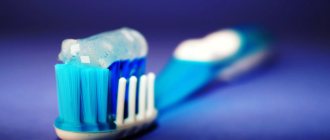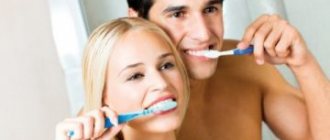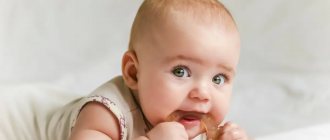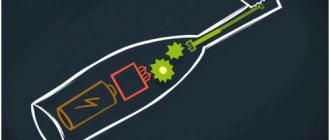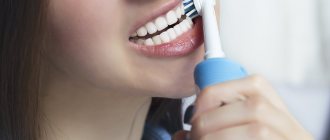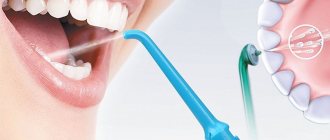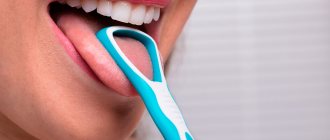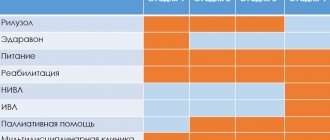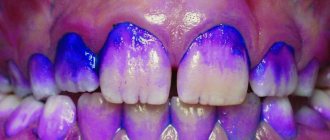Not all parents know how to properly brush their children’s teeth, but The condition of the erupted permanent teeth depends on the quality of care for baby teeth.
. To protect your child from problems with molars, incisors and canines, it is necessary to teach him to brush and rinse his mouth after the very first tooth erupts.
Features of the structure of milk teeth
Baby teeth form in the sixth week of fetal development. Normally there are 20 of them:
- 8 molars;
- 8 incisors;
- 4 fangs.
Temporary teeth consist of the same tissues as permanent teeth:
- dentin (in temporary teeth it is softer and less mineralized);
- enamels;
- pulp.
However, primary incisors, canines and molars have features:
- low crowns;
- large distance between crowns;
- long thin roots that dissolve before the temporary tooth falls out and the permanent tooth erupts;
- thin enamel - only 1 mm;
- wide channels.
The structure of baby teeth is only slightly different from permanent teeth, so they no less need proper care. You can start brushing your child’s teeth after the very first incisor has erupted.
. Early training in hygiene will be an excellent prevention against many dental diseases that can affect the primary incisors, and then the rudiments of the permanent ones formed under them.
If you don’t care for your baby’s teeth or care for them incorrectly, your baby will have to visit pediatric dentists already in the first three years of life. Or he may tolerate drilling rotted teeth with a bur, which is painful and unpleasant for a small child, even with high-quality anesthesia.
Features of jaw development at 8–13 years of age. Changeable bite
The main thing that happens to a child’s teeth at this age is that they change to permanent ones. This condition of the jaw in adolescents is called a mixed bite.
By the age of 3, the child has 20 temporary teeth, which began to grow from the age of six months. They are gradually replaced by indigenous ones (with normal development, complete replacement occurs by 13–14 years). 8–12 chewing teeth also appear, which immediately erupt as permanent teeth.
During the period of change of occlusion, the roots of baby teeth dissolve, preparing the place for new, permanent teeth. The change in bite begins at the age of 6 and lasts for the next 8. The sequence of teeth change is the same for all children, but the boundaries of the periods may vary. The front milk teeth are the first to be renewed - just remember the photographs of first-graders on school rulers! At this time, children's jaws are actively growing, and gaps appear between the teeth necessary to freely accommodate molars - they are always larger than baby teeth. Constant changes in the structure of the jaw will occur in a child up to 14 years of age.
The formation of a bite is a very long and important process, on which the health and appearance of the child in the future largely depends. Therefore, it is necessary that from 6 to 14 years of age he undergoes an annual examination by an orthodontist. The doctor will ensure that the teeth are correctly positioned in the dental arch, and will also monitor their size, shape, and enamel characteristics. It is much easier to track bite deviations in childhood or adolescence than to correct them when the child grows up.
How to properly clean a baby's mouth
Immediately after being discharged from the hospital, you need to start wiping the newborn baby’s gums with a thick gauze swab dipped in water. You can also wet the tampon in:
- chamomile infusion, if the baby does not have constipation;
- bactericidal infusion of sage;
- St. John's wort decoction, as this plant strengthens the gums;
- anti-inflammatory decoction of calendula.
It is not recommended to use decoctions and infusions of herbs to treat the oral cavity of a baby more than 2-3 times a week, as their abuse can lead to allergic reactions.
Maintaining hygiene, which involves treating the oral mucosa with a gauze swab, is necessary for both newborns who are breastfed and those children who are fed artificial formula. Breast milk does not clean the oral cavity, but pollutes it. If you do not sanitize your baby’s mouth after feeding, then pathogenic bacteria will begin to multiply in it, which can lead to infection of the tooth enamel.
At what age should a child start brushing his teeth?
You need to start brushing your baby's teeth from the moment they begin to erupt.
At first, it is better to perform manipulations without paste, carefully treating not only the first tooth, but also the gum itself. You can use a special soft baby brush or a silicone pad that is placed on the parent’s finger. The last device will serve not only as a brush, but also as a gum massager, which will ease the pain from teething.
You should act carefully during the cleaning process, since the gums near the cutting tooth are inflamed and painful, so infants may react poorly to the hygiene procedure. But you cannot refuse it: during teething, local immunity deteriorates, so the risk of infection of the enamel increases.
More details about caring for the oral cavity of a newborn are described in the video:
How to properly brush children's teeth
There are several general rules for high-quality teeth cleaning, depending on the age of the baby:
- A child under one year old should brush his teeth using a special silicone pad, which is fixed on the parent’s index or thumb.
- After a year, you can use a brush with silicone bristles and a special limiter, gradually switching to classic models.
- From the age of three, a regular brush with soft bristles is used. It is important that its surface is covered only by two dental crowns, otherwise the hygienic procedure will not be effective enough.
A baby brush needs to be changed every 3-4 months. If the service life has not yet expired, but the brush has already become rough around the edges, you should change it, since pathogenic bacteria can begin to form and multiply between the bristles.
How to brush the teeth of a child under 1 year old
Six months is the age when parents should start brushing their child’s teeth every day.
From 6 to 12 months, children are cutting teeth, so during this period it is necessary to sanitize their oral cavity very carefully. The baby cannot yet take part in the hygiene procedure, but can already express his dissatisfaction with sounds and gestures, so the adult should focus not only on the dental cleaning technique, but also on the baby’s sensations.
How to properly brush your first teeth
Key cleaning rules:
- the necessary movements should be sweeping: from the root to the top;
- the finger with the silicone attachment should be in the child’s mouth at an angle of 45 degrees to the gums;
- when processing chewing surfaces, the finger with the nozzle is positioned horizontally and cleans the crown with progressive longitudinal movements;
- The inner surface of the teeth is cleaned with short, quick movements;
- The side teeth can be cleaned using circular movements.
There should be about 10–15 movements per tooth. During the procedure, it is necessary to clean not only the dental enamel, but also the inner surface of the cheeks, tongue and gums. You can also brush your one-year-old child's teeth using special dental wipes, which can be purchased at the pharmacy.
Why you need to teach your child to brush their teeth earlier than one year
You should start brushing your baby's baby teeth when the first incisor appears or even before it fully erupts. Complete oral care will help:
- form the correct bite;
- It is good to clean the oral cavity from cariogenic bacteria;
- prevent various diseases, including caries.
How to brush teeth for children over one year old
A child over 1 year old can purchase their first toothbrush with silicone bristles. It costs more than a regular one, but such a waste of money is justified: a brush with silicone bristles will not injure the child’s teeth and will help to thoroughly clean the gums and cheeks. You can use it to clean even your child’s first teeth. However, such brushes quickly become unsuitable for safe use, so they should not be used for a long time.
Rules for caring for a children's toothbrush with silicone bristles
In order for the silicone brush to last longer, you must follow the following rules for its operation:
- Do not boil or even simply pour boiling water over the brush;
- After each use, you should wash it with soap (baby, tar, laundry).
The brush should not be placed in a case; it should be stored in a closed cabinet, in a glass, separately from the brushes of adult family members.
Which pasta should you choose?
Before buying toothpaste, many modern parents go online to read reviews, but you shouldn’t trust them: many reviews are left on request in order to increase sales. The advertising is aimed primarily at women, since they are usually the ones who buy such things.
The main myth that can often be found in such reviews is the enormous harm of fluoride for children.
Fluoride or calcium: which is better for a child?
Fluoride is not poison at all. This substance is beneficial, including for children. Dental societies in many countries around the world have conducted studies that have proven that fluoride-containing toothpastes are absolutely not harmful.
You can often see that children should use a paste containing calcium, but this is not at all true.
When choosing pasta, you need to take into account the age of the direct consumer.
- Children under 1 year. This is the only age when it is better to purchase a paste with calcium in its composition, since during this period of time the tooth enamel is still quite weak and contains few minerals. Children often swallow the paste, so it should not contain parabens and sodium lauryl sulfate, which pose a health hazard. Fluoride-containing paste can be dangerous only where there is an increased fluoride content in the water: an excess of this substance can cause the development of fluorosis. If a filter is used, it can retain most of the fluoride, which will lead to its deficiency and, as a consequence, the development of caries. Read more about children's toothpastes here.
- Children from one to 6 years old. During this period, you can use a paste with fluoride, making sure that its content in the composition does not exceed 500 ppm. Pastes with calcium can also be used, provided that the child either does not have caries at all, or a single case of carious formation has been recorded.
- Children over 6 years of age. For children of this age, the concentration of fluoride contained in the paste should be increased to 1000 ppm.
Advice for parents who want to rid their child of dental problems:
- It is better to alternate different pastes: use a paste with calcium in the morning, and one with fluoride in the evening.
- You can get by with a calcium paste, but after each brushing, rinse your mouth with a special fluoride-containing liquid. Remember that such a liquid cannot replace a thorough cleaning!
Toothpastes for one-year-old children and infants
To start brushing children's teeth using toothpaste, it is not necessary to wait until the child is one or three years old. Most toothpastes are indicated for children over 2 years of age, however, there are a number of manufacturers whose product lines include good fluoride-free toothpastes suitable for children under one year of age. They are completely harmless and can be swallowed. Such products can be found among the brands:
- ROCS
- Elmex.
- Splat.
- Lacalut.
Each toothpaste indicates at what age it is approved for use - you need to brush your child’s teeth only with a product that is not contraindicated for him and is suitable for comprehensive care of children’s teeth.
When starting to brush the teeth of a child under one year old using toothpaste, you need to monitor his reaction. Some babies may develop allergies, so at the first symptoms of a rash or an incomprehensible cough, you should stop using the paste and show your baby to a doctor.
Teeth brushing technique with toothpaste
You can start brushing your teeth with toothpaste when the child’s first incisor appears, the deadline is one and a half years.
You shouldn’t wait until he develops caries due to lack of proper care.
Brushing procedure with toothpaste:
- a certain amount of paste is applied to a pre-moistened brush;
- the brush is brought at a right angle to the crowns;
- The tooth surface must be cleaned using sweeping movements: from the roots to the tops;
- The inner dental surface is cleaned with short movements, the brush is placed at an angle of 45 degrees;
- the cutting and chewing surfaces of the crowns are processed at the very end;
- after completing the procedure, you should rinse your mouth with water;
- The approximate duration of each cleaning is 2–3 minutes.
2–3 years old is the age when you need to start teaching your child to brush their teeth on their own.
How to choose a toothbrush for a child
In this age group, both manual and electric brushes can be used. Brushes and attachments should be replaced every 2–3 months, as well as immediately after an acute infectious disease.
When choosing a suitable brush, pay attention to the following criteria.
- Age of the child. This is simple - pay attention to the age marking when choosing. For brushes recommended from 3 to 5 years, the length of the handle does not exceed 15 cm and the length of the head is 2 cm. From 5 to 8 years, the handle is up to 17 cm, the head is 2–2.5 cm.
- The stiffness of the bristles. Soft or ultra-soft bristles are suitable for children.
- Handle - should have anti-slip silicone or rubber inserts. Since fine motor skills are still developing, the brush should be such that the child can confidently hold it in his hands.
- Design. A brush with a bright design or with a favorite character will help get your child interested in brushing their teeth.
How to teach a child to brush their teeth
Many children under 1 year old, and sometimes older children, do not want to brush their teeth, expressing their dissatisfaction in every possible way. In this case, it is necessary to attract their attention to the hygiene procedure using one of the following methods:
- buy a bright brush with your favorite cartoon character and toothpaste with a pleasant fruity taste;
- invite your child to brush the teeth of his toys;
- brush your teeth with your child and compete with him in the quality and speed of brushing.
Each parent independently decides at what age to start brushing their child’s teeth and whether to use toothpaste, but delay can negatively affect the baby’s health. Parents should not only brush their children’s teeth, but also teach them how to properly care for their mouth on their own.
Dr. Komarovsky talks in more detail about children’s teeth, caring for them and teaching a child to brush:
ABOUT THE IMPORTANCE OF THE PROCEDURE
Some parents mistakenly believe that caring for baby teeth is a waste of time, because over time they will be completely replaced by molars. Dentists assure that this is not so: tooth enamel is very thin in any case, the sugar contained in food can damage it, which, in turn, will cause infection, including sore throat and pyelonephritis.
In addition, a diseased tooth does not take part in the process of chewing food, which will negatively affect its digestion. If caries is advanced, there is a risk of tooth extraction, which will negatively affect the bite, and can also cause curvature of permanent teeth and the occurrence of defects in the pronunciation of certain sounds. That is why competent and timely care is necessary.
